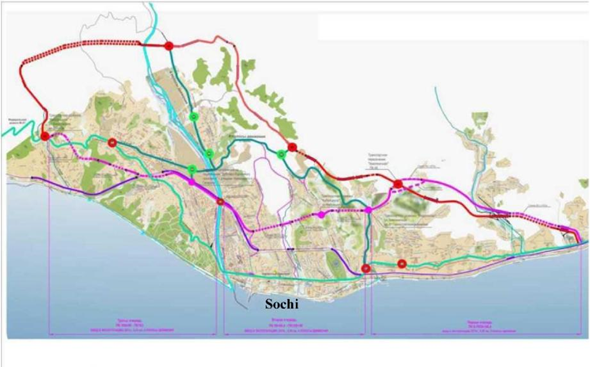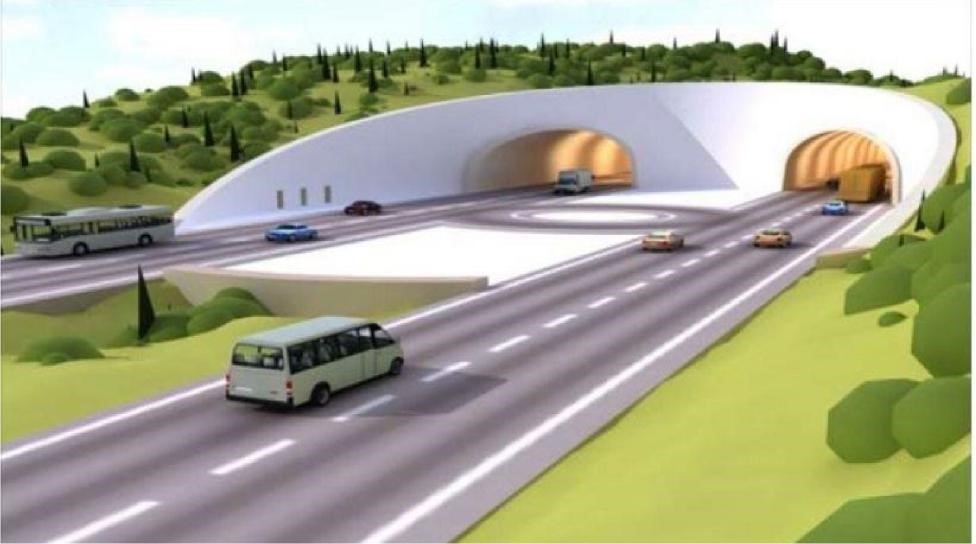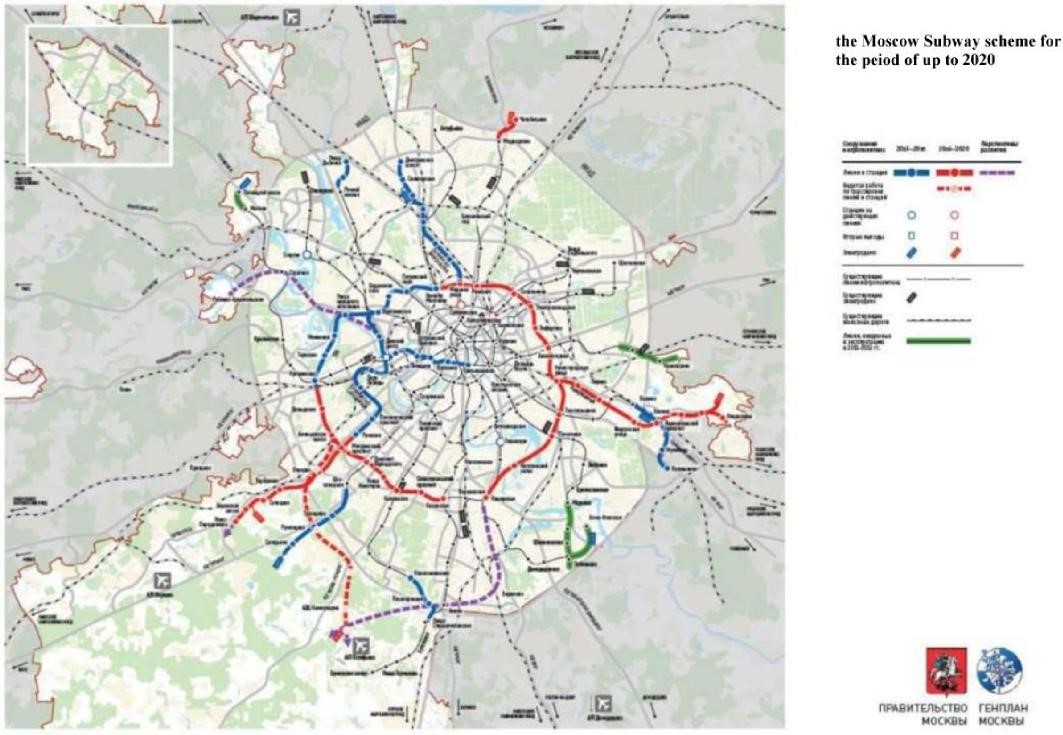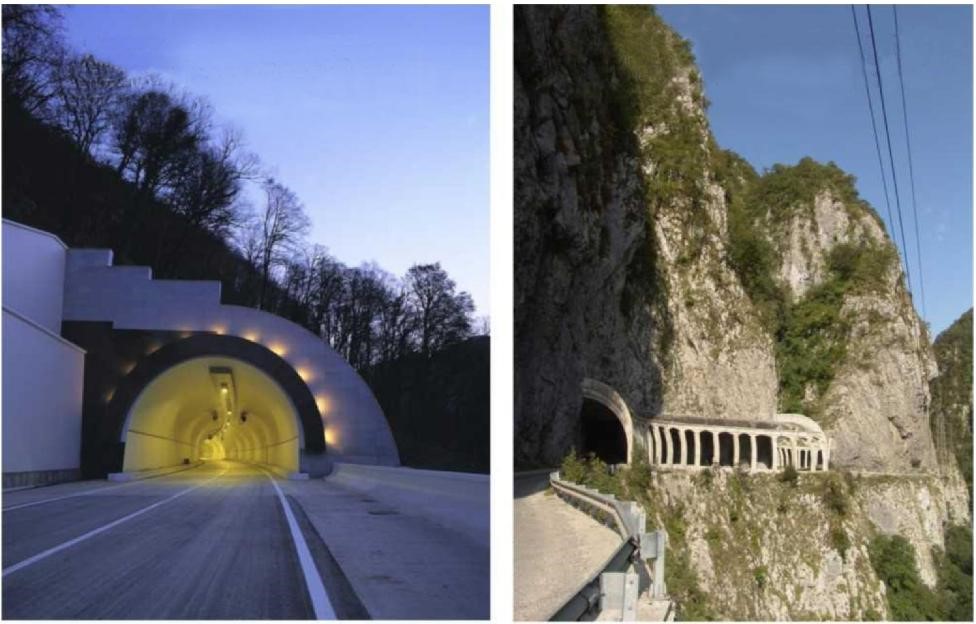
Russia Activity Report PDF
Construction Program of transportation facilities in SochiKuzhel V.N., FGU DSD "Chernomorje", Russia
By 2013 in Sochi, the Federal Road Agency (Rosavtodor) will build and upgrade 41.8 km of federal highways and 5 transport interchanges - the main transport hubs of the city, completely solving the problem of so-called bottlenecks by redistributing traffic on the streets of the city center including:
1."Detour of Sochi" - 17.8 km. It was commissioned in 2009. Includes: 5 tunnels, 15 via-ducts, 5 transport interchanges.
2. Federal highway M- 27 at the Adler-Vesyoloe section – 8km. commissioning was in 2013. Includes 7 platforms and 4 transport interchanges.
3. Reconstruction of section between transport interchanges "Adler Ring" and "Golubye Dali" ("Union") with the length of 0.3 km. Commissioning was in 2012.
4."Central Motorway “Double of Kurortnyi avenue” with the length of 16.59 km. Commis-sioning 2013. Motorway includes 9 tunnels (6 of them are paired), 11 overpasses (8 of them are paired) and 8 transport interchanges. Commissioning of the facility into operation was in December, 2013.

Pic.1 Double of Kurortnyi avenue
In accordance with the transport and logistics service scheme of the XXII Olympic Games of 2014, the road of Sochi’s central highway “Double of Kurortnyi avenue” is the basic vehicle construction, providing communication between the Big Sochi and mountain cluster areas. The entire route is divided into three stages, which have independent value and feasibility of construction.
Versions of passage for all motorway stages were considered by urban Commission, which included representatives of all matching instances. The final version for each stage of “Double of Kurortnyi avenue” was adopted under conditions of the most rational allocation of highway for use in an environments. In order to minimize the demolition, the impact on the natural landscape, the entire route (90%) is paved in the tunnel and overpass design, harmoniously blending into the urban areas.
The 1st stageof the “Double of Kurortnyi Avenue” is 5.67 km in length. The highway takes its origin from Agura River and ends at Zemlyanichnaya Street.
Parameters:
|
Length km |
N° of lanes |
Estimated |
Tunnels |
Bridges pc/km |
Transportation pc |
|
5.67 |
2 |
100/75 |
3 / 2.5 |
3 / 2.63 |
2 |
The construction of three tunnels is provided as a part of stage 1 of the “Double of Kurortnyi Avenue”.
Tunnels N°1 and N° 2with the length of 1.47 km and 0.67 km (respectively) are made of reinforced solid concrete and have an inner horseshoe shape. Transverse section of tunnel lining provides clearance for a 2-lane road tunnel, sanitary, electro technical equipment and communications, as well as signalling devices, communications and ventilation. Tunnel N°1 has two lanes in width 3.75 m each and two safety lanes 0.5 m each.

Pic. 3 Tunnel N°1
Project provides improvement of areas for emergency stop measuring 54m X 2.75m. The construction of evacuation passages is stipulated between existing Matsestinsky tunnel and the tunnel N°1. The width of the roadway of tunnel N°2 is 9.35 m. On the both sides of the roadway tunnels N° 1 and N° 2 service passages with the width of 0.75m are provided.
Tunnel N° 2a is projected at the entry of the track “Double of Kurortnyi avenue” to the transport interchange PC 45 in the direction to Dzhubga on "Detour of Sochi". Road section with the length of 312.9 m consists of the tunnel with the length of 259.2 m and portal junction sections with the total length of 53.7m.

Pic. 4 One-lane tunnel N°2a transverse section
Tunnel 2a is represented on the plan by an «S»- shaped curve.
Project envisages device niches on each side chequer wise to accommodate the equipment and fire stations along the length of all tunnels.
Due to the fact that throughout the stage 1 the Double’s track iterates track 1of the Detour of Sochi Launch Facility, put into operation in 2001, a decision was made to use the 2 roads simultaneously, with the division of flows on the forward and reverse directions. The road under construction will be used for movement in the direction of the Adler-Sochi-Dzhugba and existing site of Detour of Sochi (the 1st launch facility) - Dzhubga-Sochi-Adler.
As a part of the 2nd and 3rd stages of the “Double of Kurortnyi Avenue”, the construction of six separate two-lane tunnels for forward and reverse movement is provided.

Pic.5 Paired tunnels transverse section
Construction length of stage 2 of the “Double of Kurortnyi Avenue” is 5.32 km from Zemlyanichnaya Street to Sochi River.
Parameters:
|
Length km |
N° of lanes |
Estimated speed, km/h |
Tunnels (paired) pc/km |
Bridges, pc/km |
Transportation interchanges, pc |
|
5.32 |
4 |
100/75 |
3/2.11 |
4/2.35 |
4 |
The lengths of the tunnels of the 2nd stage of the “Double of Kurortnyi Avenue” are:
·Tunnel N° 3- 660.79 m;
·Tunnel N° 3a- 683.5 m;
·Tunnel N° 4- 668.4 m;
·Tunnel N° 4a- 669.4 m;
·Tunnel N° 5- 670.5 m;
·Tunnel N° 5a- 695.7 m
All tunnels are two-lane in each direction with a width of carriageway of 2 X 3, 75 m

Pic.6 Design of double tunnel portals
Motorway “Double of Kurortnyi avenue” is concluded by the 3rd stage from Sochi River to Psahe River, the length of which is 5.33 km.
Parameters:
|
Length km |
N° of lanes |
Estimated speed km/h |
Tunnels (paired) pc/km |
Bridges pc/km |
Transportation interchanges, pc |
|
5.33 |
4 |
100/75 |
3/2.70 |
4/2.00 |
2 |
The lengths of the tunnels as part of Stage III of the “Double of Kurortnyi Avenue” are:
· Tunnel N° 6- 554.8 m;
· Tunnel N° 6a- 564.1 m;
· Tunnel N° 7 -804.2 m;
· Tunnel N° 7a -824.2 m;
· Tunnel N° 8- 1561.9 m;
· Tunnel N° 8a- 1538.1 m.
All tunnels are two-lane in each direction with a width of carriageway of 2 X 3,75 m. Construction of tunnels in the composition of the 3rd stage of the “Double of Kurortnyi avenue” is provided in the coastal lowland part of the Sochi coast.
To ensure effective and prompt management of the main groups of engineering systems of all tunnels, the project envisages the creation of an automated technical processes control system (ATPCS). To provide comprehensive security for vehicles in tunnels and portal junctions stations project envisages the creation of an automated traffic management system (ATMS). Tunnels are protected. Portals provide security posts. Before the inbound tunnel portal an opportunity to tap vehicles in case of emergency within the tunnel is provided – there is an ability to turn the transport around before the portals with departure to the opposite direction lane.
Thus, with the implementation of projects for the construction of the Olympic transport infrastructure by Rosavtodor, Sochi will become a modern comfortable resort, equally comfortable for living and for tourism. City modern development is inseparable from the upgrading of the existing road transport network and the introduction of new high-class road tracks.
MOSCOW METRO PROSPECTS
M. S. Khusnullin, Deputy Mayor of Moscow on urban and construction policies
To solve the transport system problems of the capital, the Moscow Government took a strategic decision on the design and implementation of the Moscow Metro development program for the period of up to 2020, because both today and in the future the metro will remain the main transport artery of the city.
One of the main factors ensuring the growth and development of any region or city is the development of transport infrastructure...
Strategic solution for solving the problems of the city transport system was the decision of the Moscow government on the design and implementation of a large-scale development program of the Moscow Subway during the period of 2011-2020. Simply put, more than 160 km of transmission lines and 70 stations to be built in the capital in ten years.
Both today and in the future the Moscow metro system is the main traffic artery of the city. Daily traffic volume is of about 9 million people. At the same time, the extension deficit of Metro in 2012 was about 200 km, and 22 % of Muscovites were not serviced by the metro at all. Implementation of plans for Moscow metro construction will allow reducing this figure to 7% by 2020.
Only in 2013, 14 kilometers of transmission lines and seven subway stations are planned to be commissioned...
The most important engineering solution, designed to relieve tension in downtown area passenger traffic and shorten travel from one district to another, was the decision to build the 3rd interchange circuit (TIC), the so-called Metro’s "second ring" ... The construction of 50 km of transmission lines and 22 stations is planned.
The first section of the 3rd interchange circuit from "Nizhnyaja Maslovka" station to "Khoroshyovskaya" station (7,2 km, four stations ) is already being constructed and will have been completed by 2015.
It is clear that the solution of such major problems in a very short time, only by Moscow design and construction organizations’ forces is impossible. Therefore, relying on the power of traditional Moscow giants - OJSC "Metrogiprotrans", JSC "Mosmetrostroy", JSC "Transinzhstroy", JSC "NPO "Engeocom", a wide network of executors was created, which can solve the challenges ahead. In the center of this union there is "Mosinzhproekt" assigned to unify and coordinate the efforts of designers and builders as well as address the issues (and it is also a fundamental innovation) with urban design, construction , operating agencies, control departments and local authorities. Russian Tunneling Association, which has a composition of experienced metro construction professionals, currently does not only conduct expertise of the industrial safety projects and participates in the regulations development, but it is also directly involved in the process scientific and technical support of construction and provides monitoring and advisory support...
Such organizations as JSC "Bamtonnelstroy", JSC "ABC Inzhstroy", Kazgrazhdanproekt, SUE "URSG", Kazmetrostroy, Moselektrotyagstroy, LLC "Inzhstroyproekt" Minskmetroproekt, Kazan Giproniiaviaprom, LLC "Transtonnelstroy", LLC "Spetstonnelstroy", "Mospromstroy", JSC "SU-155", Kanalstroyproekt, etc. were involved in design and construction.
The construction of the Moscow Metro may be comparable only with China and Spain by the scope of work and their executors’ power.
Currently work is being done at 90 construction sites, which involve more than 18 thousand builders and 14 tunnel boring systems.
One of the work development directions of the Moscow Metro is studying international subway experience.
The most similar development program to the Moscow Metro is the metro development program in Madrid, where 200 km of transmission lines were built during 12 years. Construction of stations using Spanish technology reduces the cost of transport communications transfer by 25%, and carrying out work by (in) parts reduces the amount of territory occupied by the construction site.
It is also involves the study and analysis of the proposals on construction of the underground double-track tunnels, one-vaulting stations with deep foundations, the improvement of penetration of tunnels without precipitation, the introduction of a new ventilation method of underground elements with air conditioning, etc.
It is important to note that although only some elements of these complex engineering structures (stations, rolling stock, and tunnels) are visible to passengers using metro services, in fact the metro construction problem is much bigger. And one of its components is the construction (reconstruction) of industrial production base and depot, without which the Metro cannot function. Realizing the importance of this issue, we assume the problem, the solving of which was previously delayed for many years – the construction and modernization of the depot.
The list of the ongoing and future works is unprecedentedly extensive. It includes electric depots "Pechatniki, "Severnoe", "Planernoe", "Rudnevo", "Likhobory", "Novogireevo", "Mitino", "Chelobitjevo", "Brateevo", "Vladykino", "Yuzhnoe", "Sokol", "Zavod imeni Voytovycha ","Solntsevo", "Salarjevo", "Kommunarka" etc.
However, the capital’s transport problems solution, establishing an effective transport framework of the city transport requires a set of measures, so the Moscow government has developed a comprehensive program for the Moscow transport hub development, which includes Moscow subway, rail infrastructure and the Moscow region develop measures, the road network formation and transport hubs development . All kinds of surface and underground transport will be connected in a single network by 255 transport interchange units (TIUs). TIUs will appear in many subway stations and stops of the Moscow Ring (Koltsevaya) Railway, so the townspeople could leave their cars in secure and well-equipped parking and continue further way by metro.

Moscow Subway development scheme for the period of up to 2020
PROBLEMS OF SUBWAY CONSTRUCTION INDUSTRY 2014 - G.Y. Stern, Chairman of the Board Russian Tunneling Association
2013 is nearing its end - a very productive year for the Subway construction industry. Russian Tunneling Association is pleased to note that almost all of the challenges which Metro builders from Russia and the CIS countries were facing in the past year have been successfully solved. One of the most significant results is the completion of the Olympic facilities construction in Sochi. All tunnels planned for construction and reconstruction in order to solve the transport problems of the Winter Olympics, have already been put into operation and are waiting for their dear guests.
During the construction of the combined (auto- and rail-) road Adler - skiing resort "Alpika-Service" designed to deliver the audience and participants at the Krasnaya Polyana mountain stadiums, special attention was paid to environmental safety and minimizing of negative environment impacts. The road includes a range of auto-, rail tunnels and service/evacuation tunnels with total length of over 32 km.
Much of the tunnel construction program has been implemented as a part of creation of the double of Kurortnyi Avenue and other region transportation routes. This huge amount of underground construction was mastered for an unprecedentedly short time.
So, our Olympians have yet to beat the highest world records, but tunnel workers have already done it.
Significant progress has been made in the tunnels and underground structures construction in Russian cities. Most grandiose construction was organized in Moscow, which is the capital of our Motherland.
More than 160 km of subway lines and 70 stations have to be built as part of the Moscow Government strategic program for the Moscow Metro development, during the period of 2011 - 2020. Currently the construction of stations "Delovoj Centre" - " Park Pobedy" of Kalininsko-Solntsevskaya line, " Ulitsa Starokachalovskaya" - "Novoyasenevskaya" of Butovskaya line are on the final stage, stations commissioned are " Lermontovskiy prospect" and "Zhulebino" of Tagansko-Krasnopresnenskaya line . In 2014 it is planned to put into operation the "Kotelniki" station of the same line, as well as sections of "Marjina Roscha" - "Petrovsko-Razumovskaya" - "Seligerskaya" of Lyublinsko-Dmitrovskaya line, "Yugo-Zapadnaya" - " Troparyovo " - "Rumyantsevo" - "Salarevo" of Sokolnicheskaya line, "Spartak" of Tagansko-Krasnopresnenskaya line, "Tekhnopark" of Zamoskvoretskaya line, the second lobby of "Mezhdunarodnaya" station of Filyovskaya line. Simultaneously, the number of areas is under working, which has to be done by 2015 and beyond. There are more than 20 tunnel boring mechanized complexes in work; it is also a record for any World metropolis.
It should be noted that the preparation of Russia to Winter Olympic Games in 2014 and the implementation of long-term programs of the country’s transport infrastructure development have created a unique environment for modernization of one of the most time-consuming and difficult construction industry in engineering terms. That is building tunnels and subways.
Modern level of tunneling is characterized by wide introduction of new calculation and design methods, using of efficient materials, high-performance vehicles, machines, equipment.
Comprehensive exchange of experience and knowledge between specialists from different countries, of very different skills: builders, designers, researchers, developers and manufacturers of equipment, structures and materials, organizers of construction industry is important and there is no need to prove it again. One of the tools for such an exchange of experience and knowledge is to hold scientific and technical conferences, seminars and other forums on topical issues of our industry, which is widely used in the Tunneling Association practice.
Contribution of educational institutions, which train specialists to work in research, design, construction and manufacturing organizations, which, in turn, provide creating of tunnels and subways, to our common business, is great.
We should not forget about the regular technical officers training, who already graduated from schools inprevious years, and currently work for our industry. For this purpose, at the end of 2013 at the Moscow State University of Railway Engineering (MIIT) the department "Transport tunnels and subways" was established by Russian tunnelling Association. Lections at the department are conducted by leading scientists and experts involved by Tunnelling Association.
There are still a lot of dreams and plans to be implemented in 2014 and in subsequent years. Our industry is on the rise and ready to perform the most difficult tasks in the sphere of its activities...

1. Federal highway Adler-Krasnaya Polyana Reconstruction. Section KM 43‑48. There are two highway tunnels being
constructed in the area of KM 46-47. KM-48 Tunnel’s southern portal
2. Protected part of the road Adler‑Krasnaya Polyana km 23 +050- km 26+450 on the right rocky shelf of canyon AH-CU in the Mzymta River valley.

